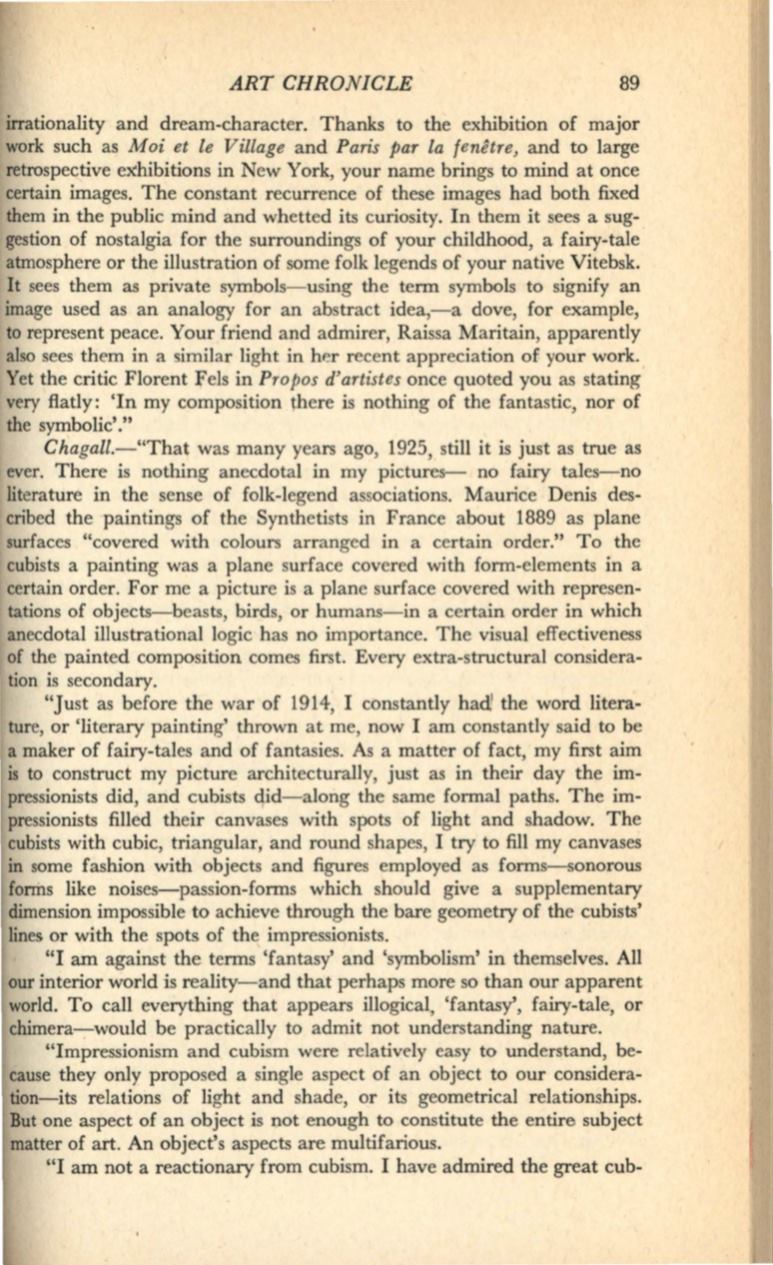
ART CHRONICLE
89
irrationality and dream-character. Thanks to the exhibition of major
work such as
Moi et le Village
and
Paris par la fenetre,
and to large
retrospective exhibitions in New York, your name brings to mind at once
certain images. The constant recurrence of these images had both fixed
them in the public mind and whetted its curiosity. In them it sees a sug–
gestion of nostalgia for the surroundings of your childhood, a fairy-tale
atmosphere or the illustration of some folk legends of your native Vitebsk.
It sees them as private symbols- using the term symbols to signify an
image used as an analogy for an abstract idea,-a dove, for example,
to represent peace. Your friend and admirer, Raissa Maritain, apparently
also sees them in a similar light in her recent appreciation of your work.
Yet the critic Florent Fels in
Propos d'artistes
once quoted you as stating
very flatly: 'In my composition there is nothing of the fantastic, nor of
the symbolic'."
Chagall.-"That
was many years ago, 1925, still it is just as true as
ever. There is nothing anecdotal in my pictures- no fairy tales-no
literature in the sense of folk-legend associations. Maurice Denis des–
cribed the paintings of the Synthetists in France about 1889 as plane
surfaces "covered with colours arranged in a certain order." To the
cubists a painting was a plane surface covered with form-elements in a
certain order. For me a picture is a plane surface covered with represen–
tations of objects-beasts, birds, or humans-in a certain order in which
anecdotal illustrational logic has no importance. The visual effectiveness
of the painted composition comes first. Every extra-structural considera–
tion is secondary.
"Just as before the war of 1914, I constantly had! the word litera–
ture, or 'literary painting' thrown at me, now I am constantly said to be
a maker of fairy-tales and of fantasies. As a matter of fact, my first aim
is
to construct my picture architecturally, just as in their day the im–
pressionists did, and cubists did-along the same formal paths. The im–
pressionists filled their canvases with spots of light and shadow. The
cubists with cubic, triangular, and round shapes, I try to fill my canvases
in
some fashion with objects and figures employed as forms-sonorous
forms like noises-passion-forms which should give a supplementary
dimension impossible to achieve through the bare geometry of the cubists'
lines or with the spots of the impressionists.
"I am against the terms 'fantasy' and 'symbolism' in themselves. All
our interior world is reality-and that perhaps more so than our apparent
world. To call everything that appears illogical, 'fantasy', fairy-tale, or
chimera-would be practically to admit not understanding nature.
"Impressionism and cubism were relatively easy to understand, be–
cause they only proposed a single aspect of an object to our considera–
tion-its relations of light and shade, or its geometrical relationships.
But one aspect of an object is not enough to constitute the entire subject
matter of
art.
An object's aspects are multifarious.
"I am not a reactionary from cubism. I have admired the great cub-


